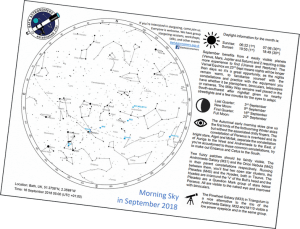Early September benefits from 5 easily visible planets (Mercury, Venus, Mars, Jupiter and Saturn) and 2 requiring a little more experience to find (Uranus and Neptune). You’ll catch Mercury, Neptune and Uranus in the morning sky and the remainder in the evening.
The Vernal Equinox on 23rd Sept means nights will be longer than days so it’s a great opportunity, as the nights remain warm, to familiarise yourself with the constellations and practice with equipment you have whether it be binoculars, telescope or camera. The Milky Way remains well placed in the South-southwest after nightfall given no nearby streetlights and a few minutes for the eyes to adapt.
Click to download the latest guide

